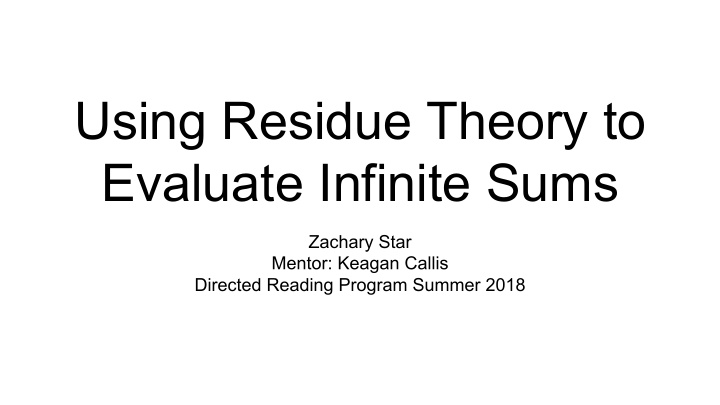



Using Residue Theory to Evaluate Infinite Sums Zachary Star Mentor: Keagan Callis Directed Reading Program Summer 2018
Definitions ● A function is called Holomorphic if it is complex- differentiable in the domain D. ● A function is called Analytic if it has a convergent power series about some point . ● A function has a Singularity at a point if it fails to be well defined at that point, or appears to “blow up” at that point. We also use some well-known results from complex analysis.
Laurent Series: Generalizing Power Series in ● We are used to using Taylor series to describe a differentiable function as a convergent series. ● Suppose that we have a function analytic in some neighborhood around a point but not necessarily at that point . ● Then we write
Complex Integration Consider the problem of finding where C is the closed contour around a circle given by for . ● For : ● For :
Residue Theory We want an easier way to perform complex integration. Recall Integrating both sides, we find that almost every term vanishes. We therefore call the negative first coefficient in a function’s Laurent Series its Residue at .
Cauchy’s Residue Theorem For a function having residues inside a contour, we have the following formula.
Calculating Residues We want to find a formula to calculate the residues of a function with the form: Multiplying by , taking derivatives, and the limit approaching : This gives us a formula in terms of
Using the Residue Theorem: Part 1 Let , where f is a function decaying like . We note that this function has singularities at all the integers, so we use our formula to calculate the residues at these points.
Using the Residue Theorem: Part 2 Define the Contour to be the following square. We wish to show that First, we have that for sufficiently large N, We also have:
Using the Residue Theorem: Part 4 Using our bounds, we have that Which approaches 0 as N gets arbitrarily large. However, Therefore,
Using the Residue Theorem: Part 5 Finally, let . From the previous result, we have that However, Therefore, Finally,
Summary ● Defined: holomorphic, analytic, singularity, Laurent Series, and Residue. ● Proof sketch of Cauchy’s Residue Theorem ● Analyzed the function: ● By setting we showed
Source Reading ● Fundamentals of Complex Analysis for Mathematics, Science, and Engineering by Edward B. Saff, Arthur David Snider Other works consulted ● Complex Analysis by Serge Lang
Recommend
More recommend